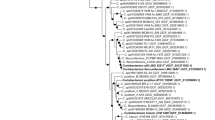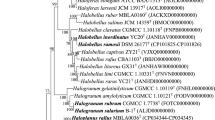Abstract
During previous studies to evaluate the phylogenetic diversity of Aeromonas from untreated waters and vegetables intended for human consumption, a group of isolates formed a unique gyrB phylogenetic cluster, separated from those of all other species described so far. A subsequent extensive phenotypic characterization, DNA–DNA hybridization, 16S rRNA gene sequencing, multi-locus phylogenetic analysis of the concatenated sequence of seven housekeeping genes (gyrB, rpoD, recA, dnaJ, gyrA, dnaX, and atpD; 4705 bp), and ERIC-PCR, were performed in an attempt to ascertain the taxonomy position of these isolates. This polyphasic approach confirmed that they belonged to a novel species of the genus Aeromonas, for which the name Aeromonas lusitana sp. nov. is proposed, with strain A.11/6T (=DSMZ 24095T, =CECT 7828T) as the type strain.




Similar content being viewed by others
References
Abbott SL, Cheung WK, Janda JM (2003) The genus Aeromonas: biochemical characteristics, atypical reactions, and phenotypic identification schemes. J Clin Microbiol 41:2348–2357
Allen DA, Austin B, Colwell RR (1983) Aeromonas media, a new species isolated from river water. Int J Syst Evol Microbiol 33:599–604
Alperi A, Martínez-Murcia AJ, Ko W-C, Monera A, Saavedra MJ, Figueras MJ (2010) Aeromonas taiwanensis sp. nov. and Aeromonas sanarellii sp. nov., two new clinical species from Taiwan. Int J Syst Evol Microbiol 60:2048–2055
Alperi A, Martínez-Murcia AJ, Monera A, Saavedra MJ, Figueras MJ (2010) Aeromonas fluvialis sp. nov., isolated from Spanish river. Int J Syst Evol Microbiol 60:72–77
Aravena-Román M, Beaz-Hidalgo R, Inglis TJ, Riley TV, Martínez-Murcia AJ, Chang BJ, Figueras MJ (2013) Aeromonas australiensis sp. nov., isolated from irrigation water in Western Australia. Int J Syst Evol Microbiol 63:2270–2276
Baumann P, Baumann L (1981) The marine gram negative eubacteria: genera Photobacterium, Beneckea, Alteromonas, Pseudomonas and Alcaligenes. In: Starr MP, Stolp H, Truper HG, Balows A, Schlegel HG (eds) The Prokaryotes, vol 2. Springer, Berlin, pp 1302–1331
Beaz-Hidalgo R, Alperi A, Figueras MJ, Romalde JL (2009) Aeromonas piscicola sp. nov., isolated from diseased fish. Syst Appl Microbiol 32:471–479
Beaz-Hidalgo R, Martínez-Murcia AJ, Figueras MJRE et al (2013) Classification of Aeromonas hydrophila subsp. dhakensis Huys, 2002 and Aeromonas aquariorum Martínez-Murcia et al. 2008 as Aeromonas dhakensis sp. nov. comb nov. and emendation of the species Aeromonas hydrophila. Syst Appl Microbiol 36:171–176
Beaz-Hidalgo R, Latif-Eugenin F, Hossain MJ, Berg K, Niemi RM, Rapala J, Lyra C, Liles MR, Figueras MJ (2015) Aeromonas aquatica sp. nov., Aeromonas finlandiensis sp. nov. and Aeromonas lacus sp. nov. isolated from Finnish waters associatedwith cyanobacterial blooms. Syst Appl Microbiol 38:161–168
Carvalho MJ, Martínez-Murcia A, Esteves AC, Correia A, Saavedra MJ (2012) Phylogenetic diversity, antibiotic resistance and virulence traits of Aeromonas spp. from untreated waters for human consumption. Int J Food Microbiol 159:230–239
Collado L, Cleenwerck I, Van Trappen S, de Vos P, Figueras MJ (2009) Arcobacter mytili sp. nov., an indoxyl acetate hydrolysis negative bacterium isolated from mussels. Int J Syst Evol Microbiol 59:1391–1396
Demarta A, Küpfer M, Riegel P, Harf-Monteil C, Tonolla M, Peduzzi R, Monera A, Saavedra MJ, Martínez-Murcia AJ (2008) Aeromonas tecta sp. nov., isolated from clinical and environmental sources. Syst Appl Microbiol 46:439–444
Esteve C, Gutiérrez MC, Ventosa A (1995) Aeromonas encheleia sp. nov., isolated from European eels. Int J Syst Evol Microbiol 45:462–466
Figueras MJ, Alperi A, Beaz-Hidalgo R, Stackebrandt E, Brambilla EM, Monera A, Martínez-Murcia AJ (2011) Aeromonas rivuli sp. nov., isolated from the upstream region of a karst water rivulet in Germany. Int J Syst Evol Microbiol 61:242–248
Hänninem ML (1994) Phenotypic characteristics of the three hybridization groups of Aeromonas hydrophila complex isolated from different sources. J Appl Bacteriol 76:455–462
Harf-Monteil C, Fleche AL, Riegel P, Prevost G, Bermond D, Grimont PA, Monteil H (2004) Aeromonas simiae sp. nov., isolated from monkey faeces. Int J Syst Evol Microbiol 54:481–485
Haynes C (1951) Pseudomonas aeruginosa, its characterization and identification. J Gen Microbiol 5:939
Huys G, Kämpfer P, Altwegg M, Coopman R, Janssen P, Gillis M, Kersters K (1997) Inclusion of Aeromonas DNA hybridization group 11 in Aeromonas encheleia and extended descriptions of the species Aeromonas eucrenophila and A. encheleia. Int J Syst Bacteriol 47:1157–1164
Huys G, Kämpfer P, Albert MJ, Kühn I, Denys R, Swings J (2002) Aeromonas hydrophila subsp. dhakensis subsp. nov., isolated from children with diarrhoea in Bangladesh, and extended description of Aeromonas hydrophila subsp. hydrophila (Chester 1901) Stanier 1943 (approved lists 1980). Int J Syst Evol Microbiol 52:705–712
Janda JM, Abbott SL (2010) The genus Aeromonas, taxonomy, pathogenicity, and infection. Clin Microbiol Rev 23:35–73
Janda JM, Bottone EJ (1981) Pseudomonas aeruginosa enzyme profiling: predictor of potential invasiveness and use as an epidemiological tool. J Clin Microbiol 14:55–60
Janda JM, Abbott S, Khashe S, Kellogg GH, Shimada T (1996) Further Studies on biochemical characteristics and serolohgic properties of the genus Aeromonas. J Clin Microbiol 34:1930–1933
Kitaura T, Doke S, Azuma I, Imaida M, Miyano K, Harada K, Yabuuchi E (1983) Halo production by sulfatase activity of Vibrio vulnificus and Vibrio cholerae O1 on a new selective sodium dodecyl sulphate-containing agar medium: a screening marker in environmental surveillance. FEMS Microbiol Lett 17:205–209
MacFaddin JF (1993) Pruebas bioquímicas para la identificación de bacterias de importancia clínica. The William & William Company, Baltimore Translation by Médica Panamericana S.S
Martin-Carnahan A, Joseph SW (2005) Order XII. Aeromonadales ord. nov. In: Brenner DJ, Krieg NR, Staley JT, Garrity GM (eds) Bergey´s Manual of Systematic Bacteriology, vol 2, 2nd edn. Springer, New York, pp 556–578
Martínez-Murcia AJ, Benlloch S, Collins MD (1992) Phylogenetic interrelationships of members of the genera Aeromonas and Plesiomonas as determined by 16S ribosomal DNA sequencing: lack of congruence with results of DNA–DNA hybridizations. Int J Syst Bacteriol 42:412–421
Martínez-Murcia A, Beaz-Hidalgo R, Saavedra MJ, Figueras MJ, Sedlacek I (2013) Aeromonas cavernicola sp. nov., isolated from fresh water of a brook in a cavern. Curr Microbiol 66:197–204
Martínez-Murcia AJ, Figueras MJ, Saavedra MJ, Stackebrandt E (2007) The recently proposed species Aeromonas sharmana sp. nov., isolate GPTSA-6T, is not a member of the genus Aeromonas. Int Microbiol 10:61–64
Martínez-Murcia AJ, Saavedra MJ, Mota VR, Maier T, Stackebrandt E, Cousin S (2008) Aeromonas aquariorum sp. nov., isolated from aquaria of ornamental fish. Int J Syst Evol Microbiol 58:1169–1175
Martínez-Murcia A, Monera A, Alperi A, Figueras MJ, Saavedra MJ (2009) Phylogenetic evidence suggests that strains of A. hydrophila subsp. dhakensis belong to the species Aeromonas aquariorum sp. nov. Curr Microbiol 58:76–80
Martínez-Murcia AJ, Monera A, Saavedra MJ, Oncina R, Lopez-Alvarez M, Lara E, Figueras MJ (2011) Multilocus phylogenetic analysis of the genus Aeromonas. Syst Appl Microbiol 34:189–199
Miñana-Galbis D, Farfán M, Lorén JG, Fusté MC (2002) Biochemical identification and numerical taxonomy of Aeromonas spp. isolated from environmental and clinical samples in Spain. J Appl Microbiol 93:420–430
Miñana-Galbis D, Farfán M, Fusté MC, Lorén JG (2004) Aeromonas molluscorum sp. nov., isolated from bivalve molluscs. Int J Syst Evol Microbiol 54:2073–2078
Miñana-Galbis D, Farfán M, Fusté MC, Lorén JG (2007) Aeromonas bivalvium sp. nov., isolated from bivalve molluscs. Int J Syst Evol Microbiol 57:582–587
Miñana-Galbis D, Farfán M, Lorén JG, Fusté MC (2010) Proposal to assign Aeromonas diversa sp. nov. as a novel species designation for Aeromonas group 501. Syst Appl Microbiol 33:15–19
Munson TE (1974) Improved KCN medium. Appl Microbiol 27:262–263
Smibert RM, Krieg NR (1981) General characterization. In: Gerhardt P, Murray RGE, Costilow RN, Nester EW, Wood WA, Krieg NR, Philips GB (eds) Manual of Methods for General Bacteriology. American Society for Microbiology, Washington, DC, pp 409–443
Stackebrandt E, Frederiksen W, Garrity GM, Grimont AD, Kämpfer P, Maiden MCJ, Nesme X, Roselló-Mora R, Swings J, Trüper HG, Vauterin L, Ward A, Whitman WB (2002) Report of the ad hoc committee for the re-evaluation of the species definition in bacteriology. Int J Syst Evol Microbiol 52:1043–1047
Urdiain M, López-López A, Gonzalo C, Busse HJ, Langer S, Kämpfer P, Rosselló-Móra R (2008) Reclassification of Rhodobium marinum and Rhodobium pfennigii as Afifella marina gen. nov. comb. nov. and Afifella pfennigii comb. nov., a new genus of photoheterotrophic Alphaproteobacteria and emended descriptions of Rhodobium, Rhodobium orientis and Rhodobium gokarnense. Syst Appl Microbiol 31:339–351
Valera L, Esteve C (2002) Phenotypic study by numerical taxonomy of strains belonging to the genus Aeromonas. J Appl Microbiol 93:77–95
Versalovic J, Koeuth T, Lupski JR (1991) Distribution of repetitive DNA sequences in eubacteria and application to fingerprinting of bacterial genomes. Nucleic Acids Res 19:6823–6831
Wayne LG, Brenner DJ, Colwell RR, Grimont PDA, Kandler O, Krichevsky ML, Moore WEC, Murray RGE, Stackebrandt E, Starr MP, Truper HG (1987) Report of the Ad Hoc Committee on Reconciliation of Approaches to Bacterial Systematics. Int J Syst Bacteriol 37:463–464
Ziemke F, Hofle MG, Lalucat J, Rosselló-Móra R (1998) Reclassification of Shewanella putrefaciens Owen’s genomic group II as Shewanella baltica sp. nov. Int J Syst Bacteriol 48:179–186
Acknowledgments
Part of the research leading to these results has received funding from the European Union Seventh Framework Programme (FP7/2007-2013) under Grant agreement No.: 311846. AMM wish to acknowledge the support provided by the laboratory GPSTM of Genetic Analysis Strategies SL. In memory of Prof. Antonio Correia, sadly passed away on January 5, 2016.
Author information
Authors and Affiliations
Corresponding author
Additional information
The GenBank accession numbers of Aeromonas lusitana genes sequences are: HQ436039 (16S rRNA), HQ442672- HQ442676 (gyrB), HQ442765-HQ442769 (rpoD), HQ442900-HQ442904 (recA), HQ443031- HQ443035 (dnaJ), HQ443125- HQ4431259 (gyrA), HQ442514- HQ442518 (dnaX), and HQ442631-HQ442635 (atpD).
Rights and permissions
About this article
Cite this article
Martínez-Murcia, A., Beaz-Hidalgo, R., Navarro, A. et al. Aeromonas lusitana sp. nov., Isolated from Untreated Water and Vegetables. Curr Microbiol 72, 795–803 (2016). https://doi.org/10.1007/s00284-016-0997-9
Received:
Accepted:
Published:
Issue Date:
DOI: https://doi.org/10.1007/s00284-016-0997-9




